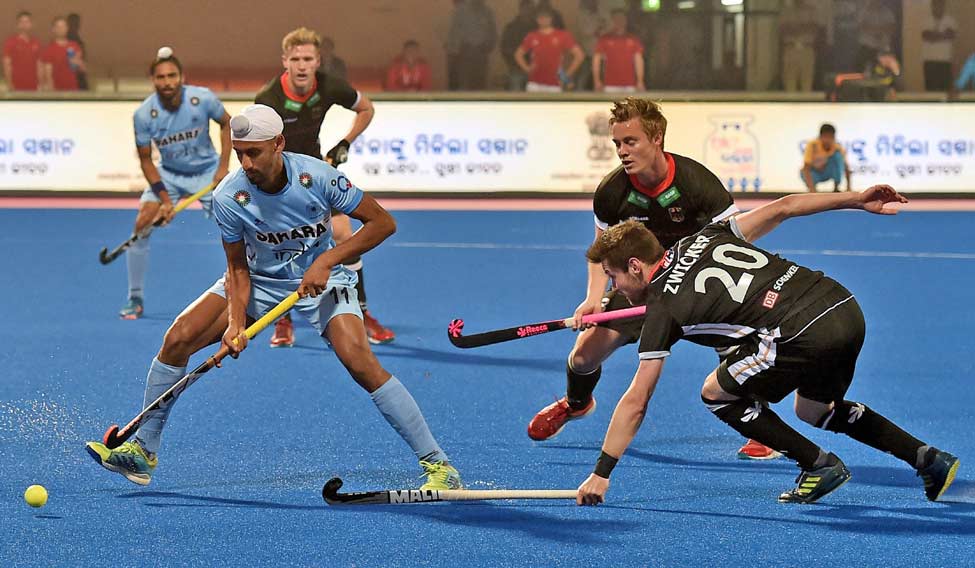There were different emotions among the 8,000-plus fans at The Kalinga. But the most consistent, ironically, amid the inconsistent Indian hockey side was that ‘they were unable to understand what was happening.’ The story began approximately at 7.30 IST in the city of Bhubaneswar, now virtually knows as Odisha’s sports hub. The Kalinga was packed by the time Australia and England had played a 2-2 thrilling draw. The hockey was fast, fascinating, played at a high speed with an extraordinary showcasing of skills and talent. It was followed by the India vs Germany match.
Now this is where you need to understand the background of the story. India recently won the Asia Cup playing a slightly different brand of hockey where the players had the freedom to build up the game on pace, skills and ball speed. Counter-attacks were supposed to be fast. India won the Asia Cup and thus expectations rose. In India when expectations rise, they climb vertically and at the speed of a rocket. So a packed stadium did expect that India would win. And not only that, they would win playing beautiful hockey. This is not to disrespect fans. But gritty wins, victories that are grinded out are not appreciated too much. So by the time the first quarter ended between India and Germany, the fans were perplexed. India had played a brand of pacy hockey against Aussies. So why were they amassing themselves between the half line and the 25’. Meanwhile, it is important to note that Germany had been playing the same formula of hockey for the last 25 years. Coaches at the sub-junior, junior and senior level teach the same methods so it’s easy to buy in.
India seemed slow. Germany held the ball and rotated like they were turning a wheel at slow speed and trying to move into the Indian striking circle. They got two chances and they scored. By the 20th minute, in the second quarter, India was 0-2 down. The crowd groaned. For most, it was unbelievable that India was struggling to come to grips on the pitch. There was no fluency, they didn’t pass smoothly and worse, they were missing passes and making a huge task of what was simple, realistic hockey.
It wasn’t easy on the eye. There were a few restless murmurs from the fans that India wasn’t having a go at Germany. But how do you do that? The Germans had latched onto the ball, passing around the midfield, like handing a relay baton and then probing into the Indian half before once again passing back to the defence and rebuilding again. In fact, once, for almost three minutes, Germany had the ball in the second quarter. India could only run after them. Once in the third quarter, Rupinder Pal Singh suddenly moved up into midfield and went after the Germans. He couldn’t fall back in time when the Germans counter-attacked.
Now after India had lost 0-2 and were consigned to the bottom of the pool, Indian coach Sjoerd Marijne said: “We lost the ball too many times. The Germans overall played extremely disciplined and had ball possession. We had more penetrations and more penalty corners. I was happy with the second half. We played really nice. We created opportunities. We have to execute them.” The Indian coach also said, “The running from Germany was really good. The team kept on fighting, and I am happy with it. Germany also made it difficult for us to play the angles we wanted to play.”
The other end of the logic came from the former Indian coach Cedric D’Souza, here at the HWL Finals, as a commentator. Cedric was the National Coach at the 94’ Sydney World Cup when India finished 5th and then at the 96’ Atlanta Olympics. “This is a process which started with the Asia Cup and would culminate at the World Cup. Every tournament has to be a stepping stone with the focus that India will be ready in a year’s time. You have to understand that this is a new system for them so they need time.”
But the bigger thing is why change the system now? And do we have enough time till the 2018 World Cup?
Marijne seems tired and stressed but yet took out some time to answer. In response to his “India had technical issues in the start of the match”, he was asked, “So what to do now?” The Dutchman answered: “Listen, Germany has been playing this system for 20 years plus. So for them to keep possession is like second skin. India has a counter-attacking game and that is what we need to develop. I know we will be good at this. And even in the next match, we will do well.”
Marijne maintains that India has the quality. They need to weave in consistency. Maybe, somewhere along the journey to the 2018 World Cup, they would also like to bring in adaptability.











